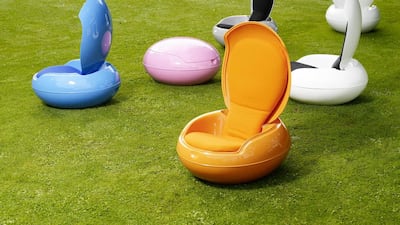Just as today’s interior design has been shaped by the global recession and the need to reduce our environmental footprint – to name just a couple of examples – designers throughout history have been inspired and influenced by prevailing economic, social and technological factors. While the 1960s may bring to mind pop music and hippie festivals, there was another powerful influence on home interior trends that came to define the decade: the space race.
While the world’s superpowers were pouring their resources into conquering the universe, designers were competing to create the most ultra-modern homes they could imagine, drawing as much from science fiction as from the realities of the decade’s breakthrough technologies. Unlike anything seen before or since, many of these iconic designs remain desirable even today.
The overarching themes of the space race were experimentation, technology, modernism and optimism; a fresh new adventure after the tragedy of two world wars and subsequent years of rationing and frugality. In architecture, increasingly bold statements were being made by the likes of John Lautner, with his iconic Chemosphere in the Hollywood Hills hovering like a flying saucer above the treeline, and Eero Saarinen, whose elegant Gateway Arch in St Louis, United States, built between 1963 and 1965, still has a futuristic feel.
Indoors, capsule- and pod-shaped furniture dominated the prevailing decor. A new minimalism echoed futuristic labs, gadgets were in high demand and everywhere you looked, spaceships and rockets lent their form to furniture, fittings and accessories.
There were a couple of key areas where the space race had a particularly noticeable effect. The first was lighting. Could there have been a more rocket-like design than the lava lamp, invented in 1963 by Edward Craven Walker? Not to mention the high-tech nature of the wax from which it takes its name. Or the various “atomic” lamps, with their UFO-shaped shades and metallic bases.
The second was chairs. Every 1960s designer worth their salt was trying to invent a unique, futuristic design that would change the way seating was viewed, using cutting-edge technologies from polypropylene plastic to foam moulding and stretch fabrics. Hence, we have the ubiquitous Polyprop chair, invented by Robin Day in 1962, which bears more than a passing resemblance to the Sputnik satellite, with its spindly chrome legs. And the 1968 Garden Egg chair by Peter Ghyczy, which opens from a flying-saucer form made of brightly coloured plastic. Also in 1968, the Panton chair by Verner Panton, a cantilevered design that was the first to be moulded from a single piece of plastic and was easily stackable.
In the kitchen, the desire for space-age gadgetry – not to mention the increasing liberation of women – gave rise to ever more sophisticated fridges and freezers, built-in ovens (far more streamlined than the previous free-standing ones), and time-saving technologies such as dishwashers and washer-dryers. There was also a rise in colourful appliances, many of which featured a removable front panel that could be replaced with one that matched your kitchen decor.
Elsewhere, clean lines were vital to the space-age look, leading to a boom in fitted furniture, with its clean lines and minimalist way of hiding clutter. Designers became cleverer at secreting elements of a room away – for example, creating disappearing tables in kitchens – and modular furniture, from shelving units to sofas, gained in popularity, too.
It’s funny to think that what we now see as retro was once considered the height of futuristic design. Then again, perhaps the homeowners of tomorrow will look back on our eco-friendly light bulbs and upcycled furniture – good for the environment and budget – and smile indulgently at the way it used to be.
Creating the space-race look
Choose bright colours
Or pure white; or a combination of the two. Just so long as you avoid subtle shades and blending tones. The 1960s were all about making a statement, and because the new polypropylene plastic of the time could be colour-matched to paint chips, designers had a field day with dramatic shades such as tangerine, fuchsia, aqua and lime. But you won’t go wrong if you stick to white, which brings to mind spacesuits, pristine labs and all the other futuristic fancies of a generation obsessed with who would be the first to land on the Moon.
Choose moulded plastics
This is by far the most important addition to your 1960s space-race-themed look. You’ll need at least one of the iconic chairs of the decade – ideally a set. If you really want to get authentic, try to source yourself a retro TV or radio, with funky plastic boxing.
Choose unusual shapes
Whether it’s a pod chair or a kidney-bean table with a tripod leg formation, forget traditional and go for outlandish wherever you can. Remember, this look was, in many ways, about making a statement about the future and how different it would be to the bleak decades that had just passed, so embrace wacky and unusual when recreating your look.
Choose built-in furniture
While your chairs and accessories should be making a statement, your storage furniture should be as sleek and minimalist as possible. Large built-in units are ideal, especially if they’re finished in some sort of laminate to create a high-tech sheen. Clever touches like pull-out shelving and modular units that slot together to save space are also a good choice.
Choose kitchen gadgets
Chances are that you’ve got most of the so-called “modern technology” that wowed housewives in the 1960s. But if your appliances are all white or silver, think about changing them for colourful ones. Yes, white and silver might feel more space age to us, but if you want a true 1960s kitchen, it’s all about embracing colour. Add as many smaller gadgets as you can, too, from coffee makers to electric can-openers and electronic food mixers – all in your theme colour, naturally.
weekend@thenational.ae

